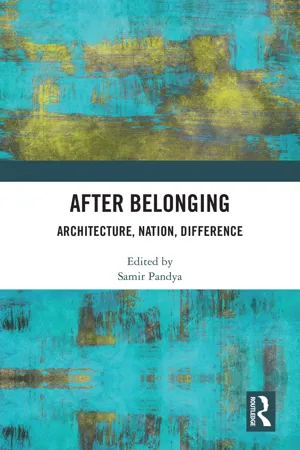
- 136 pages
- English
- ePUB (mobile friendly)
- Available on iOS & Android
About This Book
This book breaks new ground in demystifying the relationship between architecture, nationhood, and other forms of collective identity. It attempts to extricate the oppressive ideology of national identity entrenched within the very idea of architecture. Authors investigate themes such as cosmopolitanism, diaspora, geopolitics, globalisation, hybridity, and race. Certain chapters expose highly regulated environments which support cultural hegemony, such as the context of a hostel for 'coloured colonial seamen' in London, the illusionary rhetoric of 'authenticity' used to legitimise architectural conservation, and the role of the mosque as mediator between a post-war, multi-racial Britain, and ideas of nationhood. Others engage subjects at the urban scale, including the phenomena of universities transcending their nation-building roots to become agents of cosmopolitan urbanism, and how the discursive context of a high-profile yet unrealised modernist office-block in the City of London sustained a culture of British faux-nationalism. Remaining chapters adopt a postcolonial lens, with one examining how particular works of literary fiction reimagine notions of 'place' within an emerging intercultural nation, and another exploring the tense relationship between identitarian form and affective atmospheres to suggest the possibility of anti-essentialist experiences of architecture.
Together, these perspectives propose an alternative vision of the City, where neither state-sponsored identity politics nor right-wing populism determine the cultural context within which architects design for our collective urban experience. This book will be of interest to researchers and advanced students of Architecture, Anthropology, History, Human Geography, Politics, Sociology, and Urban Studies.
The chapters in this book, except for chapter 1, were first published in the journal National Identities.
Frequently asked questions
Information
Table of contents
- Cover
- Half Title
- Title Page
- Copyright Page
- Dedication
- Table of Contents
- Citation Information
- Notes on Contributors
- Acknowledgements
- Foreword: The Nation State
- Preface
- 1 Introduction—After belonging: architecture, nation, difference
- 2 Architecture in National Identities: a critical review
- 3 ‘Accounting for the hostel for ‘coloured colonial seamen’ in London’s East End, 1942–1949’
- 4 ‘A place for the unexpected, integrated into the city structure’: universities as agents of cosmopolitan urbanism
- 5 Placing in-between: thinking through architecture in the construction of colonial-modern identities
- 6 Affective disorder: architectural design for complex national identities
- 7 Questioning authenticity
- 8 The mosque and the nation
- 9 Architecture and faux-nationalism: reflections on a remark made by the British architectural historian Gavin Stamp about the German-American architect Ludwig Mies van der Rohe
- Index